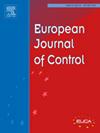在 BGC 测量和输注胰岛素存在未知启动延迟和量化的情况下,为 1 型糖尿病患者提供基于周期事件的血糖调节功能
IF 2.5
3区 计算机科学
Q2 AUTOMATION & CONTROL SYSTEMS
引用次数: 0
摘要
本文章由计算机程序翻译,如有差异,请以英文原文为准。
Periodic event-based regulation of blood glucose for type-1 diabetic patients in the presence of unknown actuation delay and quantization in BGC measurement and infused insulin
In this paper, a delay-independent observer-based truncated predictor output feedback controller is considered to overcome the problem of glucose regulation in the normoglycemic band in type-1 diabetes mellitus (T1DM) patients. The proposed controller confronts with various difficulties such as unannounced meal intakes (modeled as disturbances), sampled and quantized measured blood glucose concentration (BGC) level due to the mechanism of the continuous glucose measurement (CGM) device as a digital glucose sensor, quantized infused insulin as the output of the digital insulin infusion pump, and an unknown input delay in the automated delivery system. The automated delivery system with three fundamental elements CGM device (as a glucose sensor), a controller for calculation of the required infused insulin, and an insulin infusion pump provides a closed-loop glucose–insulin regulatory framework for T1DM patients in order to effectively regulate the BGC level and keep it in the normoglycemic band (i.e., 70-180 (mg/dl)). An observer is applied for the estimation of the unmeasured state variables of the system. Furthermore, a periodic event-triggered strategy is introduced to specify whether it is required to send the information of the CGM device (as the sensor) for the controller. Moreover, another periodic event-triggered strategy is proposed to determine whether it is needed to change the infusion rate of the insulin pump (as the actuator). Benefiting from these periodic event-triggered strategies, the communication and energy consumptions of the automated delivery system are reduced. A sufficient condition on the delay’s upper bound value is obtained in order to assure the local exponential stability (LES) of the glucose–insulin regulatory system. Design of the controller has been done based on the nonlinear Bergman minimal model (BMM) as a so-called model for control design purposes in T1DM patients. Also, the proposed approach is validated on 10 adult virtual patients (VPs) with a large-scale and multi-compartmental model that is the base of the UVA/PADOVA Type-1 Diabetes Simulator in the presence of the unannounced meal intakes.
求助全文
通过发布文献求助,成功后即可免费获取论文全文。
去求助
来源期刊

European Journal of Control
工程技术-自动化与控制系统
CiteScore
5.80
自引率
5.90%
发文量
131
审稿时长
1 months
期刊介绍:
The European Control Association (EUCA) has among its objectives to promote the development of the discipline. Apart from the European Control Conferences, the European Journal of Control is the Association''s main channel for the dissemination of important contributions in the field.
The aim of the Journal is to publish high quality papers on the theory and practice of control and systems engineering.
The scope of the Journal will be wide and cover all aspects of the discipline including methodologies, techniques and applications.
Research in control and systems engineering is necessary to develop new concepts and tools which enhance our understanding and improve our ability to design and implement high performance control systems. Submitted papers should stress the practical motivations and relevance of their results.
The design and implementation of a successful control system requires the use of a range of techniques:
Modelling
Robustness Analysis
Identification
Optimization
Control Law Design
Numerical analysis
Fault Detection, and so on.
 求助内容:
求助内容: 应助结果提醒方式:
应助结果提醒方式:


